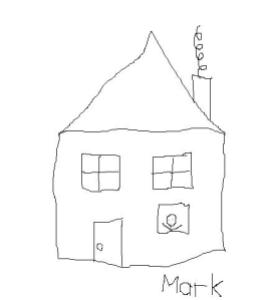Every Saturday morning, instead of going to synagogue like the Torah commands, I sit in my living room and watch my wife watching what I’ve come to call “house shows.” You know what I’m talking about. Shows where people decorate houses, renovate houses, buy houses, sell houses. Shows where contractors troll the parking lots of Home Depot and Lowe’s, looking for the unsuspecting owners of living rooms and yards in desperate need of television crews.
wife watching what I’ve come to call “house shows.” You know what I’m talking about. Shows where people decorate houses, renovate houses, buy houses, sell houses. Shows where contractors troll the parking lots of Home Depot and Lowe’s, looking for the unsuspecting owners of living rooms and yards in desperate need of television crews.
The first house show that I remember was called This Old House, hosted by Bob Vila and his flannel shirt. At the end of the show would be an old residence, beautifully restored, like a Victorian or Neanderthal cave. I don’t know how the show began because the only reason I went to that channel was to watch Gummi Bears, and This Old House came on right before it, and in my haste I sometimes went to the channel before This Old House had ended. And as Bob Vila sat back on the stained porch he had just added to a Sumerian mud hut, I would say to myself, “How could someone stand to watch a show like this?”
Fast-forward about fifteen years, and pretty much the only kind of show we watch in my house is a show like that.
I never understood the interest in these house shows. A show put together by professional contractors and designers. People that know how to knock down walls, pour concrete, and install plumbing. People that can rearrange entire homes in their minds. People that can draw a straight line. Homeowners, living in ordinary homes, with ordinary husbands who would rather be writing blogs than hammering nails, watch these shows and wonder why their homes don’t look like the homes on television.
Because the houses on these shows are far from ordinary. Kitchens with a backsplash made of tile reclaimed from a Pompeian mosaic dug out from two tons of igneous rock. New living room floors from hard wood reclaimed from that house that got swallowed up in Poltergeist. The only thing that isn’t reclaimed is my use of the remote control.
And the shows all have catchy names. One show that’s been getting a lot of playing time is called Property Brothers, where one brother is a real estate agent who shows the homeowners a few houses they like, and then leads them to a house they can afford, and the other brother helps stays up all night renovating it to look like the houses they liked.
I think a better show would be called Property Spouses. The home would be already bought, and it would be husband/wife team that would help decorate it. The husband would put in a leather couch and large television, and the wife would come in afterwards, replace the couch with a fabric chaise lounge and the television with a baby, and make the husband redecorate the garbage right out the kitchen.
Another show that gets a lot of playing time is called House Hunters. Here is a typical episode. A young couple puts on camouflage and grabs their rifles and heads out into the woods. A small cape cod, three bedroom, two bath, leans over a brook and takes a cool drink. The man is slow to unshoulder his rifle, but his wife is quick, sets her sight, and fires. Her aim is true, but the house heard the husband’s Droid beeping and turned, catching the wife’s round in the chimney. Panicked, the cape cod runs through the woods leaving a trickle of blood running down the outdated — but in good condition — vinyl siding. The wife and her husband set in pursuit. She gets off a few more rounds, but it turns out the home is a short sale, and the bank holds on to it until long after rigor mortis has set in.
But the house show that has become my favorite is probably DIY Disaster. In each episode, a pair of homeowners have an unfinished project, so they bring in a professional contractor to finish the project while the homeowners stand around drinking coffee. In one episode, a man had attempted to fill an inground swimming pool in the middle of the couple’s living room. But halfway through the project, he had gone insane from too many viewings of that “discount double-check” commercial with Aaron Rodgers, and was committed to an asylum with the pool only halfway dug out. Further complicating the situation was that to save time he had started filling the pool up with water as he worked, so that the halfway dug out pool was halfway filled with water, and the standing water had become home to many bugs and aquatic life.
Luckily, the host of the show arrived on the scene and was able to finish the project, using the aquatic life as independent contractors. The sea otters turned out to be natural talents, and were used in subsequent episodes, until a labor organizer got hold of them and had them balancing picket signs on their noses.


